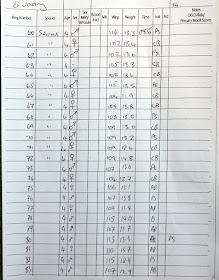Andy and I checked the local Sand Martin colony yesterday where we found approximately 200 Sand Martins together with enough holes in the quarry face to accommodate the possibility of 100 pairs. And all of this from a colony which has increased from a handful of pairs 4 or 5 years ago to its present size due to a period of gravel extraction. The colony is on private farmland where Chris the farmer is rightly proud and protective of his Sand Martins.
Everything looked right for a go at catching Sand Martins on Friday morning with a slight breeze from a friendly direction and a morning sun that would not shine directly on our single mist net. Andy and I were joined by Craig who next week flies off to bird observatories in Sweden and Denmark to further his University studies of birds.
Although we all had breakfast before we set off there was a posse of Grey Herons hoping to snaffle an early meal from Chris’ lake. This last week has seen an increased number of Grey Herons about as the yearlings begin to fledge nests and explore their surroundings.
Grey Herons
With such an active colony of Sand Martins a catch was assured. When we totalled up we found the catch to be 85 birds made up of 42 adult females, 34 adult males, just 3 fresh juveniles and 6 individuals left unsexed. One Sand Martin, an adult female, had been ringed elsewhere on a previous occasion as recognised by an unfamiliar ring beginning D996. The totals point to very few flying juveniles being around but obviously many more to come in the weeks ahead. So as not to disrupt the colony our next catch is scheduled for a week or two ahead when sun, wind and fine weather allow.
Field sheet - Sand Martins
Adult Sand Martin
Juvenile Sand Martin
Sand Martin
Eighty-five Sand Martins kept us pretty busy and so limiting birding time to 8 Oystercatcher, 8 Tree Sparrow, 1 Buzzard, 2 Mute Swan, 8 Canada Goose.
Log in soon to Another Bird Blog for more news, views and lots of birds.
Linking today to Anni's Birding and Eileen's Saturday Blog.
Linking today to Anni's Birding and Eileen's Saturday Blog.





It is awesome to hear the Sand Martins are doing so well. You are being kept busy banding these cute birds. Love the heron shot and the cute Sand Martins. Happy Birding, have a great weekend!
ReplyDeleteI am so happy to hear about the Sand Martins, Phil. I love the blue herons, too, thank you so much for sharing. :)
ReplyDeletethe martins are beauties! love the gathering of herons!
ReplyDeleteHi Phil, thanks so much for your comment on my blog. The Canadian joke...I should have explained it, but I will here for you. Tim Horton's is a very popular hangout and coffee place in Canada, including among police officers...hope this helps. :)
ReplyDeleteGlad to hear the good news about the Sand Martins too. They are so cute. The herons are pretty special also.
ReplyDeleteGreat stuff Phil. Glad to hear they are doing so well in your area. I enjoy watching them on my patch. Great to have them fly so low over my head making a racket.
ReplyDeleteHi Phil, I wanted to stop back and say thank you for linking up and sharing your post. Have a happy weekend!
ReplyDeletebeautiful......................I wonder how you are able to catch them in your hands!!
ReplyDeleteI have been reading fairly extensively recently on bird banding and its effectiveness, rates of recovery, data gleaned from it, and it appears to be quite minisicule, and seems to be an obsolete method of tracking avian movement. It would appear that there are far more effective methods these days, and more sophistication to come. The data gleaned from one satellite-tracked bird seems to far outweigh anything gathered from banding. I know of at least two academic ornithologists here who have basically called for an end to the practice. I can see its value when colour-banding birds to establish movement within a known population, rates of replacement of dead birds by floaters and that kind of thing, but the rationale for endless banding of species regardless of any known benefit eludes me. This is not a comment on banders and I check with the banding station at one of the reserves I monitor every time I am there. My wife bakes muffins for the guys. They are our friends. I just really don't understand why they do it, other than satisfaction for them. It certainly appears to benefit the birds very little, and unquestionably causes them stress.
ReplyDeleteDavid. Try this.
ReplyDeletehttp://britishbirds.co.uk/article/bird-ringing-still-necessary/
The sand martins are pretty- especially the little ones. I have always loved the herons..I don't usually find many together.
ReplyDeleteGood work (and pics) Phil. I read the bird-ringing link.
ReplyDelete~
The martins are VERY pretty!!
ReplyDeleteAs are the herons....
But you mentioned single mist net....to us laymen, what is that? I'm curious.
This must be such exciting work! The sand martins are just lovely!
ReplyDeleteThe world needs more farmers like Chris! Good for him. I assume those sweet birds are related to swallows as they look sort of like them maybe?
ReplyDeleteOh I am so happy that I checked to see what I missed...Sand Martins, just too, too sweet!
ReplyDelete